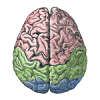8.1: Introduction
- Page ID
- 12609
When you think of memory, you probably think of episodic memory -- memory for specific episodes or events. Maybe you can remember some special times from childhood (birthdays, family trips, etc), or some traumatic times (ever get lost in a supermarket, or get left behind on a hike or other family outing?). Probably you can remember what you had for dinner last night, and who you ate with? Although this aspect of memory is the most salient for us, it is just one of many different types of memory.
One broad division in memory in mechanistic, computational terms is between weight-based and activation-based forms of memory. Weight based memory is a result of synaptic plasticity, and is generally relatively long lasting (at least several 10's of minutes, and sometimes several decades, up to a whole lifetime). Activation-based memory is supported by ongoing neural activity, and is thus much more transient and fleeting, but also more flexible. Because weight-based memory exists at every modifiable synapse in the brain, it can manifest in innumerable ways. In this chapter, we focus on some of the most prominent types of memory studied by psychologists, starting with episodic memory, then looking at familiarity-based recognition memory, followed by weight-based priming, and activation-based priming. We'll look at more robust forms of activation-based memory, including working memory, in the Executive Function chapter.
Probably most people have heard of the hippocampus and its critical role in episodic memory -- the movie Memento for example does a great job of portraying what it is like to not have a functional hippocampus. We'll find out through our computational models why the hippocampus is so good at episodic memory -- it has highly sparse patterns of neural activity (relatively few neurons active at a time), which allows even relatively similar memories to have very different, non-overlapping neural representations. These distinct neural patterns dramatically reduce interference, which is the primary nemesis of memory. Indeed, the highly distributed, overlapping representations in the neocortex -- while useful for reasons outlined in the first half of this book -- by themselves produce catastrophic interference when they are driven to learn too rapidly. But it is this rapid one-shot learning that is required for episodic memory! Instead, it seems that the brain leverages two specialized, complementary learning systems -- the hippocampus for rapid encoding of new episodic memories, and the neocortex for slow acquisition of rich webs of semantic knowledge, which benefit considerably from the overlapping distributed learning and slower learning rates, as we'll see.
Countering the seemingly ever-present urge to oversimplify and modularize the brain, it is critical to appreciate that memory is a highly distributed phenomena, with billions of synapses throughout the brain being tweaked by any given experience. Several studies have shown preserved learning of new memories of relatively specific information in people with significant hippocampal damage -- but it is critical to consider how these memories are cued. This is an essential aspect to remember about memory in general: whether a given memory can actually be retrieved depends critically on how the system is probed. We've probably all had the experience of a flood of memories coming back as a result of visiting an old haunt -- the myriad of cues available enable (seemingly spontaneous) recall of memories that otherwise are not quite strong enough to rise to the surface. The memories encoded without the benefit of the hippocampus are weaker and more vague, but they do exist.
In addition to being highly distributed, memory in the brain is also highly interactive. Information that is initially encoded in one part of the brain can appear to "spread" to other parts of the brain, if those memories are reactivated and these other brain areas get further opportunities to learn them. A classic example is that episodic memories initially encoded in the hippocampus can be strengthened in the surrounding neocortical areas through repeated retrieval of those memories. This can even happen while we are sleeping, when patterns of memories experienced during the day have shown to be re-activated! Furthermore, influences of the prefrontal cortex Executive Function system, and affective states, can significantly influence the encoding and retrieval of memory. Thus, far from the static "hard drive" metaphor from computers, memory in the brain is a highly dynamic, constantly evolving process that reflects the complexity and interactions present across all the areas of the brain.


